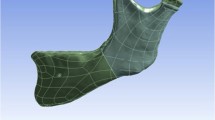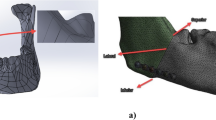Abstract
Background
The current clinical procedure for mandible fracture fixation is plate application. 3D reconstructions are used to validate procedures numerically preceding experimental analysis. This study outlines the methods used to reconstruct a numerical model of the mandible.
Methods
A CT scan from a 22-year-old male patient with a healthy unfractured mandible was obtained. A 3D reconstruction was carried out using Mimics via thresholding and segmentation techniques. Boundary conditions and muscle forces were applied, and simulations were performed using ABAQUS.
Results
3D reconstruction allows for precise anatomical dimensions, which can be used for further engineering analysis. Using the surgical Champy technique as an example, results showed that the mandible model returned to normal function post-plating.
Conclusions
The study shows the clinical relevance of 3D reconstructions to plan surgical procedures. Results illustrate the benefit of carrying out numerical validations as a prerequisite to experimental modelling and as a method of pre-validating surgical procedures.






Similar content being viewed by others
References
Fernandez JR, Gallas M, Burguera M et al (2003) A three-dimensional numerical simulation of mandible fracture reduction with screwed miniplates. J Biomech 36:329–337. doi:10.1016/S0021-9290(02)00416-5
Haug RH, Prather J, Indressano AT (1990) An epidemiologic survey of facial fractures and concomitant injuries. J Oral Maxillofac Surg 48:926–932. doi:10.1016/0278-2391(90)90004-L
Gear AJL, Apasova E, Schmitz JP et al (2005) Treatment modalities for mandibular angle fractures. J Oral Maxillofac Surg 63:655–663. doi:10.1016/j.joms.2004.02.016
Champy M, Lodde JP, Jaeger JH (1976) Biomechanical basis of mandibular osteosynthesis according to the FX Michelet method. Rev Stomatol Chir Maxillofac 77:248–251
Potter J, Ellis E (1999) Treatment of mandibular angle fractures with a malleable noncompression miniplate. J Oral Maxillofac Surg 57:288–293. doi:10.1016/S0278-2391(99)90674-2
Ellis E, Walker LR (1996) Treatment of mandibular angle fractures using one noncompression miniplate. J Oral Maxillofac Surg 54:864–872. doi:10.1016/S0278-2391(96)90538-8
Mimics v11.11. Materialise, Belgium. Available via http://www.materialise.com/mimics
ABAQUS v6.6-2, ©Dassault Systèmes, SIMULIA, Rhode Island, USA
Sensation SOMATOM 64. Available via Siemens AG, 2002–2008. http://www.medinnovations.usa.siemens.com/products/ct/sensation/. Accessed 6 May 2008
Korkmaz HH (2006) Evaluation of different miniplates in fixation of fractured human mandible with the finite element method. Oral Surg Oral Med Oral Pathol Oral Radiol Endod 103:e1–e13. doi:10.1016/j.tripleo.2006.12.016
Erkmen E, Simsek B, Yucel E et al (2005) Three-dimensional finite element analysis used to compare methods of fixation after sagittal split ramus osteotomy: setback surgery-posterior loading. Br J Oral Maxillofac Surg 43(2):97–104. doi:10.1016/j.bjoms.2004.10.007
Holmgren EP, Seckinger RJ, Kilgren LM et al (1998) Evaluating parameters of osseointegrated dental implants using finite element analysis. A two dimensional comparative study examining the effects of implant diameter, implant shape and load direction. J Oral Implantol 24:80–88. doi :10.1563/1548-1336(1998)024<0080:EPOODI>2.3.CO;2
Futterling S, Klein R, Straber W et al (1998) Automated finite element modelling of a human mandible with dental implants. In: Proceedings of the sixth international conference in Central Europe on computer graphics and visualization, University of West Bohemia, Campus Bory, Plzen, Czech Republic, vol 1, pp 103–110
Koolstra JH, Van Eijden TMGJ (2005) Combined finite-element and rigid-body analysis of human jaw joint dynamics. J Biomech 38:2431–2439. doi:10.1016/j.jbiomech.2004.10.014
Zee MD, Cattaneo PM, Dalstra M (2005) On the development of a rigid-body model of the mandible. In: International Symposium on Computer Simulation in Biomechanics Cleveland, Ohio, USA, 28–30 July 2005
Hart RT, Hennebel VV, Thongpreda N et al (1992) Modelling the biomechanics of the mandible: a three-dimensional finite element study. J Biomech 25:261–286. doi:10.1016/0021-9290(92)90025-V
Nagasao T, Kobayashi M, Tsuchiya Y et al (2002) Finite element analysis of the stresses around endosseous implants in various reconstructed mandibular models. J Craniomaxillofac Surg 30:170–177. doi:10.1054/jcms.2002.0310
Acknowledgments
The authors would like to acknowledge (1) funding from the Department of Mechanical and Aeronautical Engineering, University of Limerick, Ireland, (2) the Oral and Maxillofacial Clinic and Department of Radiology in the Mid-Western Regional Hospital, Ireland, and (3) Mr. Barry J. Doyle, Centre for Applied Biomedical Engineering Research (CABER), Department of Mechanical and Aeronautical Engineering, and the Materials and Surface Science Institute (MSSI), University of Limerick, Ireland.
Author information
Authors and Affiliations
Corresponding author
Rights and permissions
About this article
Cite this article
Kavanagh, E.P., Frawley, C., Kearns, G. et al. Use of finite element analysis in presurgical planning: treatment of mandibular fractures. Ir J Med Sci 177, 325–331 (2008). https://doi.org/10.1007/s11845-008-0218-z
Received:
Accepted:
Published:
Issue Date:
DOI: https://doi.org/10.1007/s11845-008-0218-z




